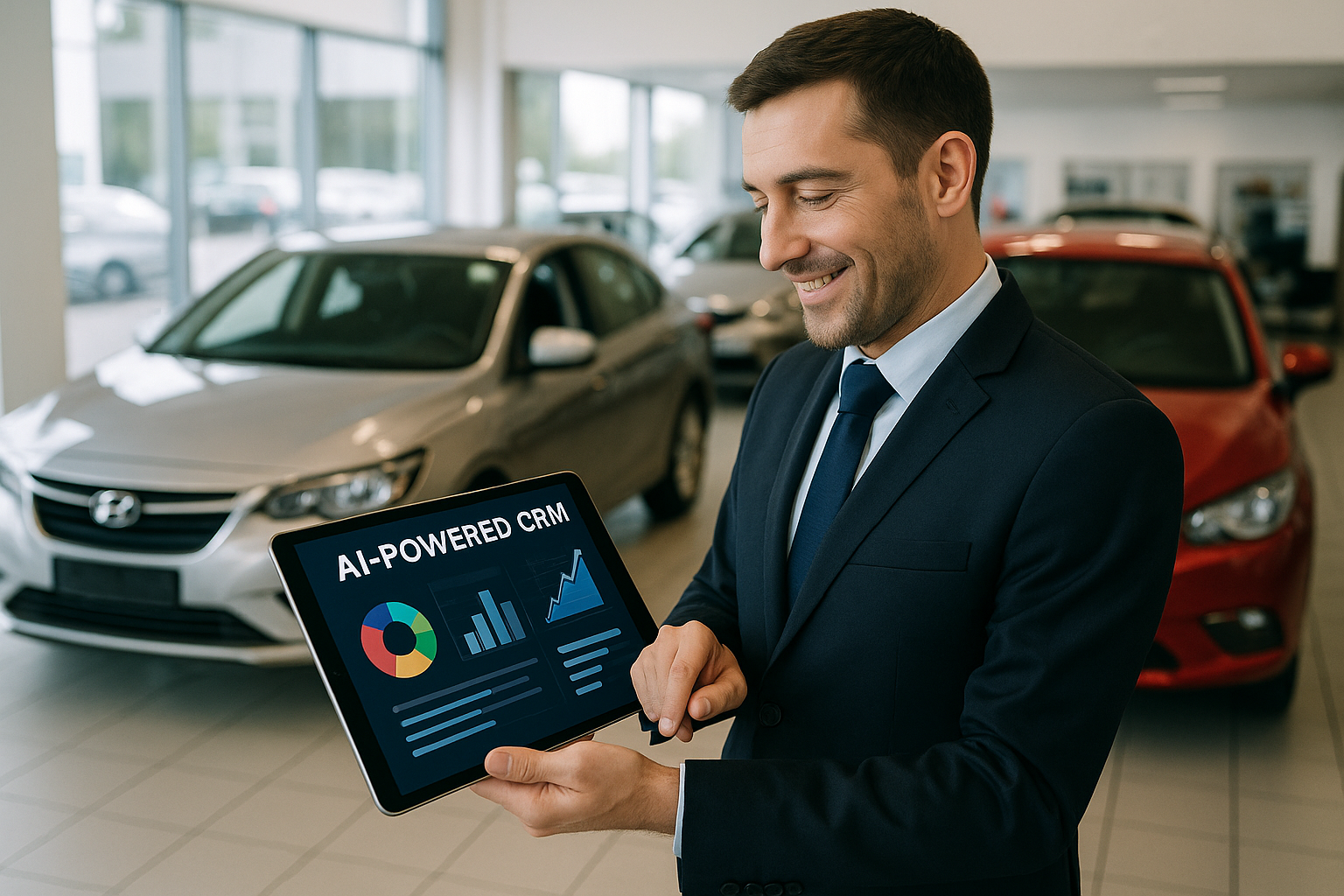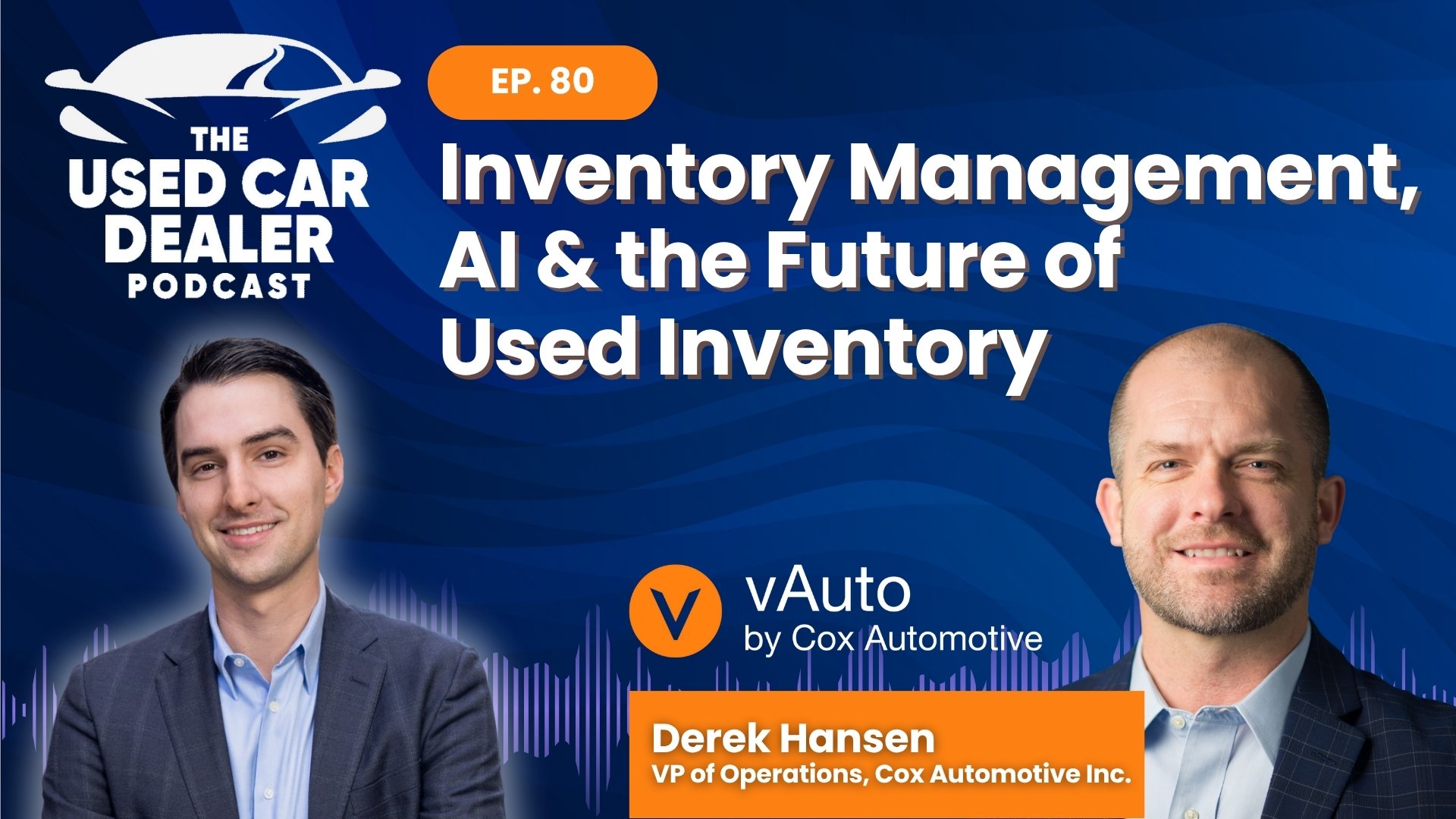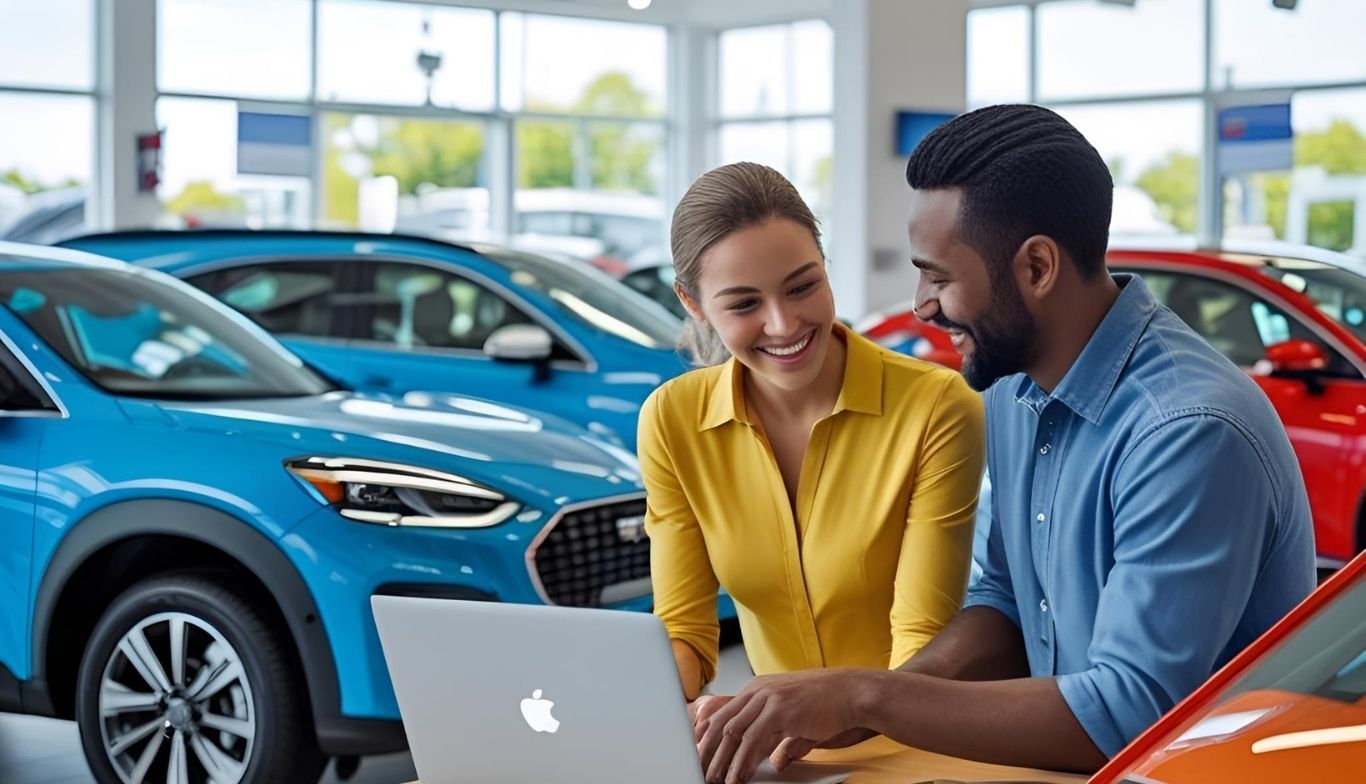In this blog post, we have transcribed the UCDP interview with David Foutz in written format. You can listen to the original podcast here.
Zach: Hello, It’s Zach and another episode of the Used Car Dealer podcast, and we have a timely guest, David Foutz, who’s the VP of sales at Cox Automotive and he oversees some of their largest brands, including Dealertrack, KBB, and Xtime. Thank you for joining the podcast today, David.
David: Zach, it is a pleasure to be with you; thanks for having me.
Zach: So, Let’s get started. For those of us listening and wondering what your role at Cox encompasses, tell us a little bit about that and how you got into the car business.
David: Yeah. So right out of college, I started selling a dealer management system, at first to motorcycle dealers, but it wasn’t long before I shifted to a business that was focused on the automotive industry, moved out here to Cleveland, Ohio, where I’ve been since 2001. My whole career has been involved with software development for dealers, sales marketing, product management, and OEMs and I’ve spent time in the fixed ops systems and since joining Cox, three and a half years ago I’ve been involved a little more with the front-end, with some of our Kelly Blue Book, VAuto, Vin and other solutions.
Zach: Nice, and let’s talk about the COVID-19 pandemic, it’s definitely top of mind for a lot of dealers and I’d like to hear your observations this year in the COVID-19 pandemic, in terms of the fixed ops side of the business as well as the retail side of the business.
David: What a ride, you know. We have a rollercoaster park out here in Ohio, Cedar Point, depending on which graph you’re looking at, this is either a big dip down followed by an up or a big up followed by a down.
I love a quote from Henry Ford where he said, “Don’t find fault, find a remedy,” and I think that’s good advice and its advice that dealers show all the time. You and I can’t necessarily influence the macroeconomic condition but we can figure out how to operate most efficiently, regardless of what’s going on around us and dealers are doing it but what have we seen?
Let’s talk about falling margins. Margin compression has been a trend since the end of World War II and somehow, miraculously in the last couple of months, it’s like we’ve rolled back the clock where inventories have been down, prices have been up, and profitability has been improving, and it shifted from ‘who has the most competitive price online’ to ‘who can be most effective at their inventory management’, who has the car that that consumer wants.
So, MMR is a tool or I think or a measurement most dealerships are very familiar with, from Manheim, We saw MMR daily retention go from 100% in February down to 90% through April and back up to 105% and now its back right at a 100% percent so, prices are starting to normalize.
If we look at vehicle prices, just a snapshot from the middle of October, year over year, you’re looking at--prices of vehicles are up, so in total 16% year over year and it just kinda depends on mid-sized cars at the lowest at 6.1% increase and pick-ups are 27.9% more expensive this year than last year, when you’re just comparing prices.
On the other hand, there’s the inventory picture; sales were up at 160% year over year, dropped to 40% in April, spiked back up to 120% in June. The message here in the data that we’re seeing is things are normalizing. October and what we predict for November sales will be right around 100% year over year and then of course, the other side of that is inventory.
Days supply, what a ride! We were at an average of 40, 45 day supply for the average dealership, used car dealership across the country in January. That spiked up to over 100 days in April and then dropped, we were seeing it as low as 20 days up high but then the news here is, inventory’s back, inventories have been growing. The average dealer’s right around 48, 50 days supply again. So, the bubble is ending or at least the data would suggest, these good times are not gonna last forever
Zach: Right. So, you mentioned margin compression and the fact that used car volume and pricing has been very strong especially this summer, why should dealers not take their eye off the ball in fighting margin compression?
David: That’s the question that we would really recommend every dealer to consider, don’t take your eyes off the ball, why? Because this isn’t a permanent change to a 40-year trend. It’s a moment in time and we could all recognize some of the external influencers that changed the economics. Those won’t last.
So, margin compression will be back, prices are coming back down, while vehicle prices are up. Wholesale prices were up too, the cost of acquiring the vehicles went up. So, margins didn’t grow as much as prices did and again as inventory rehydrates, price competition will increase, we’re gonna be right back to where we were last year we think fairly quickly.
So, don’t take your eye off the ball for your cost and for the long term. I would suggest as you’re looking at metrics, for example, to really focus on year over year rather than month over month, because we’re going through such a dynamic time.
Zach: When you look at dealerships especially, used car dealerships and their, let’s call it – speeded-up adoption of technology during the pandemic. Give me some of your insights from Dealertrack or the Xtime service front, what you’ve observed in terms of quicker adoption of technology by dealers in the pandemic.
David: Thanks Zach, so let me approach it this way. Customer expectations have accelerated. I think the behavior we’re seeing, it didn’t come out of nowhere. It’s just that consumers expected more and in some ways I think it's dysfunction and you can’t unsee something. Once you’ve used your app to place an order at Walmart and you’ve shown up at the parking lot and they walked it up to you, you know that that kind of convenience is possible like why would ever go into that store ever again.
The same thing is going on – so let’s talk about service, consumers wanted to fix their vehicles in more convenient ways. They’re influenced by their experiences online with Amazon or others. During the pandemic, service pick-up and delivery services really spiked. So, 69% of consumers say once they’ve had that experience, 69% say that’s THE thing that will drive their decision about where they get their vehicle serviced again.
We saw on the franchise dealer front over 80% of dealerships offering pick up and delivery. So ‘I don’t have to take my car for you, you pick it out from me in my driveway and you drop it back off when it's fixed’. So, adopting the tools to make that a reality and something that can be offered is really important.
An insight here for services, it’s not just the cost or dealership to add that technology or that offer. The large majority of consumers would pay $20 for convenience, an additional $20. But more importantly, dealerships that are combining video and texting with the pick-up and delivery service so while they have my car, taking a quick video that shows the technician, shows my car in the lift, shows the broken components and describes why they’re recommending a service and then they’re texting me that quote which I can then approve. Those two things with pick-up and delivery are driving $200 increase in average repair orders.
So, with the consumer expectation, there is also a new opportunity to make more revenue, digital retailing, similar transition. I mean, dramatic transition for how many dealerships are extending beyond their physical store limitation. So 88% of used car dealers tell us they have something in place to connect and do business beyond their physical location.
And 65% of independents say they are actively implementing a digital retailing system for their business. On the consumer side, 73% increase in those interested in transacting and finalizing a deal online and 2 out of 3 consumers state that they strongly prefer digital retail (we call it DR) as a way to buy a car.
That’s not going away. That preference is here to stay. And it’s not just generational, it’s not just the younger buyers, it’s everyone across the board stating a preference for digital retailing.
Zach: So, discuss some of the process improvements that you’ve seen the most successful independent dealers take on during the pandemic.
David: So for digital retailing, it is about of course all of the merchandising that’s already been going on with presenting vehicles, walk-around videos, high quality photos, and all of the basics that we’ve been talking about for years.
But then adding to that the ability to present an actual payment estimate or a pretty accurate payment estimate to a consumer and a digital retailing process that ties in to lending. The other two keys that I would suggest is don’t forget to trade-in. A lot of dealerships have neglected that side of the discussion or aren’t equipped to do that digitally.
Kelly Blue Book has some great tools that can help a consumer get that third-party valuation on their trade in. We can guarantee an instant cash offer for the value, so that those adjustments once you see the vehicle in person, if needed, are understood and easy to manage. And then the third thing I would say or trap that we’ve observed is don’t forget, for those who have service operations. get the sales to service handoff.
When someone’s sitting on the chair in sales, it’s pretty straightforward to walk them over and introduce them to someone in service. You have to remember to create that same handoff online and you could do that with digital tools like Xtime where, as part of that process a seller, remote seller with a remote buyer can connect them to their service scheduling tool. It’s left for service appointments so that a transition continues.
So those are some of the keys: don’t forget financing and actually have a system that connects with lenders. Don’t forget the trade-in, everyone has a car they need to get rid of in order to buy a new one and don’t forget the sales to service hand-off
Zach: So, at Selly we’ve observed more and more dealers get inbound KBB leads to actually buy a customers’ vehicle and a lot of them, they’re not even selling a new vehicle to that customer, what have you observed in terms of like buying trade-ins from retail dealerships at the KBB arm of Cox Auto.
David: It’s really working. The consumers are having a good experience. It works best when dealerships really recognize the difference between Kelly Blue book instant cash offer and a typical sales lead. So the engagement with that consumer recognizes this is different, it’s not ‘I understand you wanna by my Ford F150’ is your opening statement, it’s ‘I understand that you have this Chevy to sell and I’m interested in it’. Now, often that leads to the second conversation which is ‘I’d like sell you my Ford F150’ but starting it in the right way and treating those customers as sellers primarily is a key to success.
But dealerships, used dealerships that are utilizing Kelly Blue Book tools are buying cars at a lower rate and at a lower cost than they can get through auctions or through other processes. They’re extending those practices to their direct interactions online or on their own website. And that third-party of Kelly Blue book, that trust in that brand, in those values is conversation for both parties and so yeah definitely strategies of acquiring precious used vehicle inventory by Kelly Blue book is working for a lot of dealers.
Zach: So, you mentioned digital retail earlier and a lot of dealers have a different idea of what digital retail might be, maybe to some it’s an e-commerce checkout widget on your website, for others it might be like an integrated credit app, how do you define digital retail from the dealer standpoint?
David: Well, it is all over the board. If you ask a dealer, do you do digital retailing? Most say yes. When you look at it, of course what they’re doing can vary widely. At Cox, we really look at it through the consumer lens. And when you do that and when you listen to car buyers, what they want is a true end-to-end digital experience.
Now, there’s variations across the board. So the hand offs between “I’m interacting with you online” and “I’m interacting with you in a phone call”, sometimes coming into the dealership, obviously for a test drive. But the traditions between online and in-store or virtual and more direct communication like what we’re having today, those are the keys to look at for great processes so that those hand-offs are smooth.
It’s frustrating to a consumer when they’re actually now talking to one of your sales reps to have to repeat themselves, that they don’t know all the information I’ve filled into your form online. Or that we’re starting over with the credit discussion when I thought I already submitted information to get approved.
Those are the most frustrating moments: those disconnects. And so, the right processes have to take it end-to-end. Not because the consumer will go from A to Z, but because you need the flexibility. They might go from A to D online, jump in your store for E through F, then back online for the rest, if that makes sense Zach.
Zach: Makes perfect sense. And I wanted to ask you about some of the futures. What’s your opinion on EV vehicles and the changes fixed ops will have in terms of personnel, tools, facilities. Because it’s not like a traditional gas vehicle. An oil change, for instance, that wouldn’t exist in EV vehicles. So what are your thoughts on EVs as it relates to fixed ops.
David: Yeah, so electric vehicles has been something we’ve been looking at and talking about for ten years plus. Adoption, it seems, like in every step of the conversation, has been slower than perhaps people expected. And that continues today. Although there’s a lot of press about TESLA, when you look at the actual vehicles in operation and the percent that electric vehicles represent and are likely to represent, even with strong growth, this is going to be a slow impact to fixed operations.
Cox is really interested in electric vehicles and in helping our partners stay in front. For example, running Manheim, we have a common use case where there’s battery problems with the vehicle that’s at the auction. We had to develop systems and processes and equipment to quickly recharge and address battery issues because you can’t drive it through the lane at all if the battery’s dead.
So, there’s technologies that will continue to improve and the battery is a big issue obviously on electric vehicles. I think the challenges and opportunities with fixing the car or truck itself will be very manageable. My advice to dealerships as they look forward is to worry less about electric vehicle impact and worry more about your consumer expectations and interacting with them in a way that they prefer.
You’ve got to take a digital retailing experience to your service department as well as your sales department to retain customers going forward. That will be more important and more impactful to your business.
Zach: So, give me a peek ahead at 2021 and what are some of the key trends to protect profitability at the dealership.
David: Let me answer that in two parts, if that’s okay. So, how do you protect profitability? I would say, first you have to stay focused on the data. Times have not been normal. Don’t take your eye off the ball. So what does that mean? Your dealer management system, your solutions have insights, the best kind of solutions give you good dashboards. Make sure that you’re having the practices to look at those indicators and to pay attention to your costs and continue to manage your business carefully.
So, another issue with systems and focusing on data is--at Cox we provide a person with the tool. We provide a performance manager who is an expert and who is like a personal trainer that shows up every three to four weeks with insights, with questions and with accountability to help you improve your business and work on your business. So, make sure that you continue to recognize those opportunities to improve margins and manage costs.
Secondly, along that same line, it is still about driving efficiencies, so the average used car dealer is paying $32 per day per vehicle of carrying costs. We’ve got to keep our eye on that. And it leads to natural questions: how is your reconditioning process? How many days is it taking you to turn an acquisition of a vehicle into “this vehicle is presented online” ready to sell. Continue to work on taking hours if not days out of that process.
And then secondly as you think about driving efficiencies throughout the business, I would say look at duplicate efforts and eliminate them. So, one of the things I used to do, I used to do some dealership consulting, is walk around the dealership and watch for people writing things down on paper. Any time I saw someone taking a pen and writing something down, it was a signal that there was inefficiency with that system or with that process.
And we really need to eliminate double entry. The right systems will be open and will partner with various software vendors and solution providers to eliminate double entry. Dealertrack has been a leader in this space decades ago creating Opentrack and was really a voice in the wilderness at the time in the automotive industry saying ‘hey, dealer management systems should be open and we should not be paying exorbitant fees to integrate to a dealers own data’.
Opentrack has been tremendously successful. There’s over 140 solution providers that integrate to that open platform. I just think that’s really key. You need the flexibility to pick the best solution for your dealership without double entry. Without those critical time wasters that not only cost you money and time but also frustrate your employees. And that really is the third thing about staffing that I think is key when it comes to preparing for the future and keeping our eye on efficiencies. 66 percent of used car dealers have told us that they’re staffing a dedicated digital retailing team now. And that’s a shift. In general, dealerships need to be attracting and hiring digital natives who work in the business. Speaking from experience, bad systems frustrate great employees, they frustrate them quickly. There’s so much ‘muda’, as the Japanese call it, or wasted effort that’s not adding any value. So, that’s sort of on the how do you drive efficiency side of my perspective.
What’s coming next? There’s so much! And the headline is AI. AI is here and it’s only going to keep expanding. And I think it’s so exciting and helpful for dealerships and consumers. None of us like to have wasted conversations. If I’m not actually looking to buy a car, I don’t really want to be talking to salespeople. And I know as a salesperson, I don’t like talking to people that aren’t really ready to buy.
There are some tremendous insights, for example, at VinSolutions, with the AI systems that we’ve launched this year. The experience gets to be better for both the seller and the buyer. We’re able to provide insights about how likely they are, or how progressed they are in their buying cycle; insights about loyalty to brand; insights about their price range; based on their actual behaviors online, and preferences, whether it’s color, or make, or brand, and then how strong we think the insight is. Because we may have a light confidence level or a high confidence level depending on the situation.
And how that plays out for dealership? If they’ve been in to buy a car from you three years ago and now they start shopping again, you’re getting that insight fired up. It’s not a lead that you paid for per se, it’s insight coming that says ‘hey, Zach is shopping again’. Three years ago, he bought his car from you. Now might be a good time to reach out and say hello. So, that’s one example of how AI is exciting and really driving efficiencies in growth for dealerships.
Zach: Awesome. And was there anything else that I didn’t mention today that you’d like to discuss or any other futures you’re excited about.
David: That is a huge question. I think we’ve talked about some great things already, Zach. I guess, to summarize my perspective on the topics. COVID has been crazy. It’s been super challenging and different, probably very different than we expected in March. But, it’s not a permanent state.
The economic conditions look to be returning more towards year-over-year normalcy, if that’s even something we can say. But the consumer experiences are going to continue to influence preferences of our buyers, whether it’s for service or sales. And dealerships need--now’s the time, now’s a great time to invest in systems, look at your processes, how can you consistently deliver the experience the consumer wants, and fill the holes.
If your digital retailing system is not covering the trade-in question, it’s not able to actually consummate the deal online with digital signatures and financing, there’s solutions out there for you. So, evaluate them and be serious about putting them in place, not only to attract those new customers that you’ll miss in the future when that’s a hard requirement but also to drive efficiencies to help your staff be more excited to work there as well.
So, technology is a very sound answer when it’s done right, and now’s the time to investigate, and challenge, and select the right vendors to support your business.
Zach: I couldn't agree more with you David, and really appreciate you coming on the show today. You’ve had some fantastic insight
David: Thank you! Great to meet you, Zach, and I look forward to talking more in the future.






.jpg)
.jpg)
.jpg)
.jpg)


.jpg)
.png)
.png)
